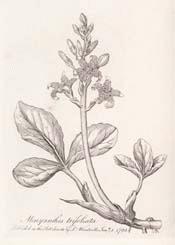
Botanical.com Home Page

|
Bogbean
(Menyanthes trifoliata)
Click on graphic for larger image
|
Bogbean
Botanical: Menyanthes trifoliata (TOURNEF.)
Family: N.O. Gentianaceae
---Synonyms---Buckbean. Marsh Trefoil. Water Trefoil. Marsh Clover.
(Dutch) Bocks. Boonan.
(German) Bocksbohne or Scharbocks-Klee.
---Part Used---Herb.
---Habitat---The Buckbean, or Bogbean, grows in spongy bogs, marshes and shallow water throughout Europe, being rather scarce in the south of England, though common in the north and in Scotland.
---Description---It is a green, glabrous plant, with creeping rootstock and procumbent stem, varying in length according to situation, covered by the sheaths of the leaves, which are on long, fleshy, striated petioles and three-partite, the leaflets being entire and about 2 inches long and 1 broad. It blossoms from May to July, the flowers being borne on long stalks, 6 to 18 inches high, longer than the leaves and clustered together in a thick short spike, rendering them very conspicuous. The corollas, 3/4 inch across, are outwardly rose-coloured and inwardly white and hairy, with reddish stamens. The Buckbean is one of the prettiest of our wild flowers deserving of cultivation in the garden, where it grows and thrives well, if planted in peat with water constantly round the roots.
---History---The plant was held to be of great value as a remedy against the once-dreaded scurvy. Scharbock, its German name, is a corruption of the Latin scorbutus, the old medical name for the disease.
'Bean' is probably an affix from the resemblance of the foliage to that of the beans grown in cottage gardens. Gerard says that the leaves are 'like to those of the garden beane.'
Its specific name, trifoliata, carries the same reference to the form of its leaves.
The generic name, Menyanthes, is from two Greek words signifying month and flower. It was a name bestowed by Linnaeus, and it has been suggested that the plant was so called because it remains in flower for a month; but it is actually often in bloom during May, June and July!
One of the older writers describes its inflorescence as a 'bush of feather-like floures of a white colour, dasht ouer slightly with a wash of light carnation.'
Buckbean has a reputation for preserving sheep from rot, but it is doubtful whether they really touch it, on account of its extreme bitterness.
---Constituents---The chief constituents are a small quantity of volatile oil and a bitter principle, a glucoside called Menyanthin. The bitterness is imparted to both alcohol and water.
---Medicinal Action and Uses---Tonic, cathartic, deobstruent and febrifuge. An extract is made from the leaves, which possesses strong tonic properties, and which renders great service in rheumatism, scurvy, and skin diseases. An infusion of 1 OZ. of the dried leaves to 1 pint of boiling water is taken in wineglassful doses, frequently repeated. It has also been recommended as an external application for dissolving glandular swellings. Finely powdered Buckbean leaves have been employed as a remedy for ague, being said to effect a cure when other means fail. In large doses, the powder is also purgative. It is used also as a herb tobacco.
The juice of the fresh leaves has proved efficacious in dropsical cases, and mixed with whey has been known to cure gout.
- In Halliwell's Popular Rhymes and Nursery Tales this rhyme occurs:
- 'Buckee, Buckee, biddy Bene,
- Is the way now fair and clean?
- Is the goose ygone to nest,
- And the fox ygone to rest?
- Shall I come away?'
These curious lines are said by Devonshire children when they go through any passages in the dark, and are said to be addressed to Puck or Robin Goodfellow. Biddy bene= Anglo-Saxon biddan, to ask or pray; bén, a supplication or entreaty. Buckee is perhaps a corruption of Puck.
Buckbean tea, taken alone or mixed with wormwood, centaury or sage, is said to cure dyspepsia and a torpid liver.
---Preparation---Fluid extract, 10 to 40 drops.
[Top]
Common Name Index
A MODERN HERBAL Home Page
Bear in mind "A Modern Herbal" was written with the conventional wisdom of the early 1900's. This should be taken into account as some of the information may now be considered inaccurate, or not in accordance with modern medicine.
© Copyright Protected 1995-2025 Botanical.com
|

